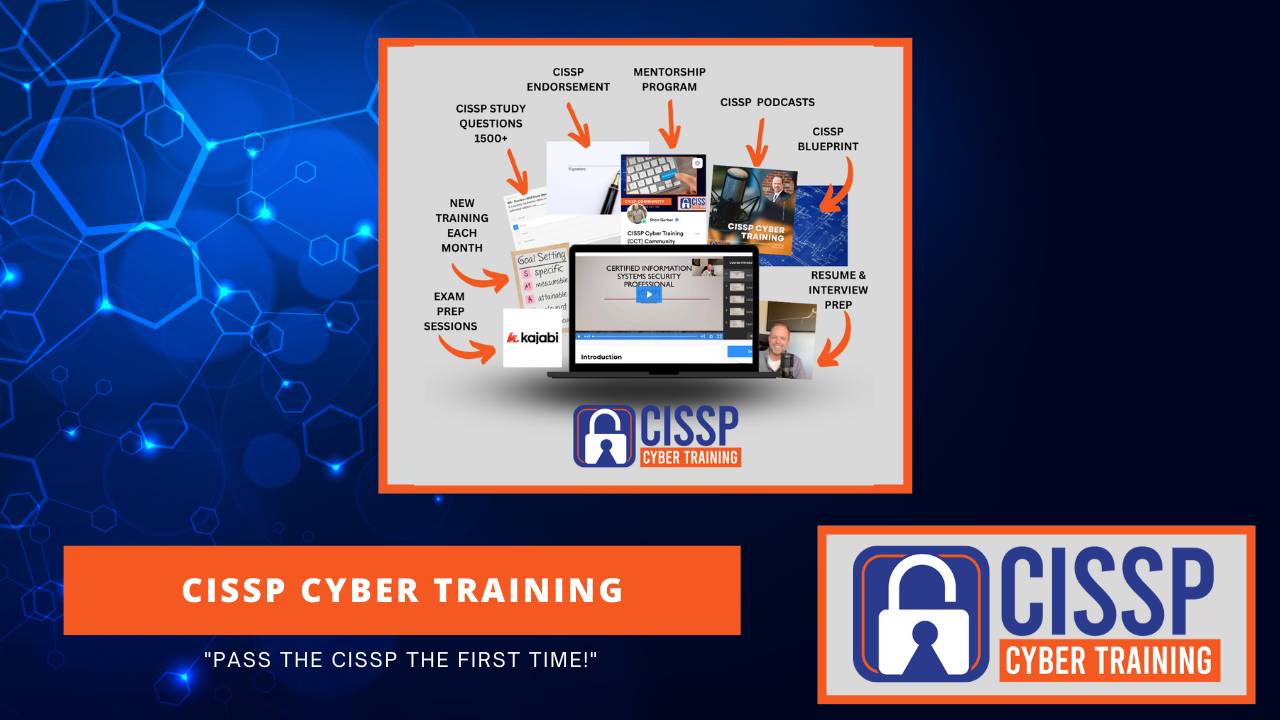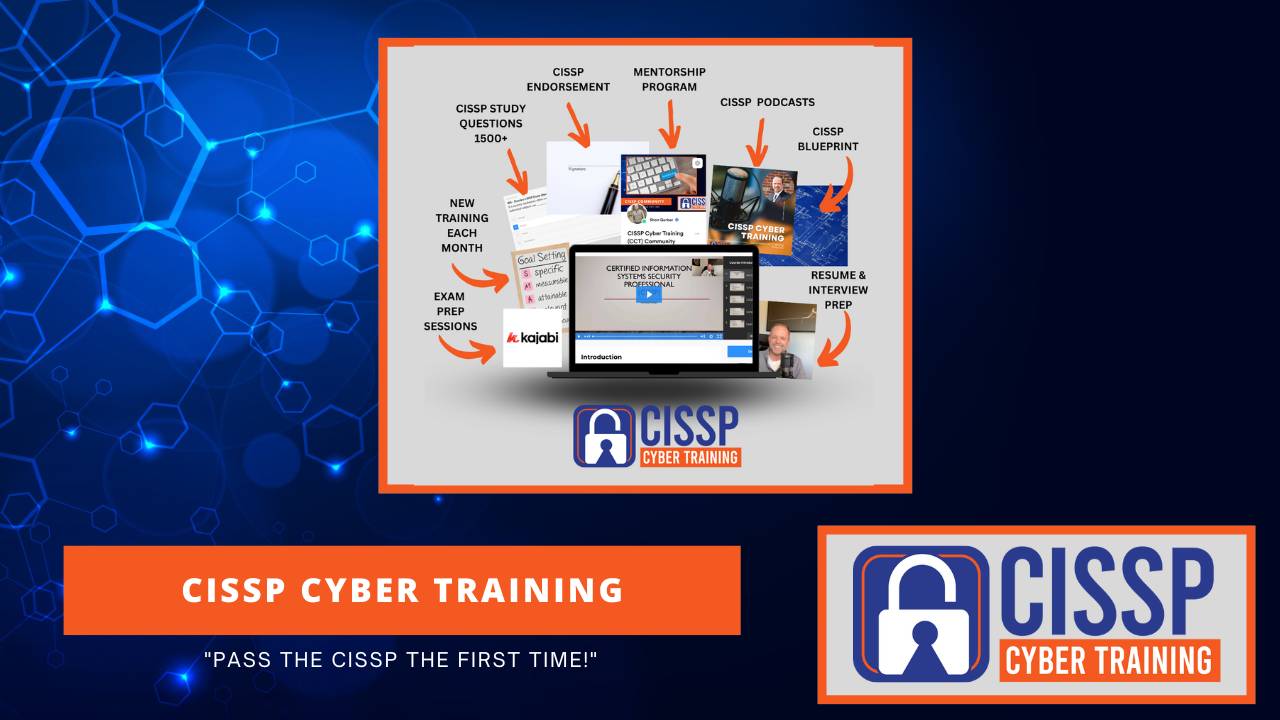CCT 039: CISSP Exam Questions (Domain 4)
May 25, 2023
CCT 039 - RCR 136 - CISSP Exam Questions (D4)
[00:00:00] Welcome to the C I S S P Cyber Training Podcast, where we provide you the training and tools you need to pass the C I S S P exam the first time. Hi, my name is Shon Gerber and I'm your host for this action packed informative podcast. Join me each week as I provide the information you need to pass the C I S S P exam and grow your cybersecurity knowledge.
Alright, let's get started.
Hey, hello. This is Shon Gerber with a C S S P Cyber Training Podcast. How are you all doing this beautiful day? And we are going to be talking about some fun things as it relates to the C I SS P exam. So today we're going into question Thursday and it is going to be focused on domain. Four. So as we get into domain four, we're gonna talk about some very key questions as it relates to the OSI model and the T C P I P model.
So the OSI model, like we've mentioned in [00:01:00] the podcast last on Monday, was around the seven layer barto, and we are gonna get into the various seven layers and we're gonna ask some key questions around those seven layers so that you can understand when you go to take your, your exam. You understand what is needed and required for the test.
So let's get started and see what we come up with. All right, question one. What is the function of the presentation layer in the OSI model? Remember we talked there are seven different layers, and presentation layer is one of those that's tied to the OSI model. So what is the function of the presentation layer in the OSI model?
A, it provides real reliable end-to-end delivery of data. It provides data for presentation of the application layer. It establishes and terminates connections between devices and it routes packets between networks. So like we talked about, when you deal with presentation, if there's something in here you [00:02:00] don't know the question about or don't know the, the answer to the question, make sure you grab and look at what might be being asked of you, and then maybe potentially pull out some questions that you know for sure that are not correct.
So obviously if it's a presentation layer, when you're dealing with data between. Uh, devices. That's probably not the presentation layer, so you could throw that one out. But again, the question is what is the function of the presentation layer in the OSI model? It provides reliable end-to-end delivery. No, it provides data for presentation.
Ah-ha. Of the application or up to the application layer, possibly it establishes terminates connections between devices, probably not. And it routes packets between networks. No, probably not. So your cr answer is B, the presentation layer. Is responsible for formatting and translating data between different systems as well as encrypting and compressing data for the transmission.
So the question or the answer is B. [00:03:00] Okay. So it formats the data in the presentation to the application layer. Question two. Which layer of the OSI model is responsible for routing packets between networks? Okay. The question is, which layer of the OSI model is responsible for routing packets between networks, a physical layer, B data link layer.
C network layer, or D transport layer. So now you're getting into routing packets. So that would probably throw a few things out for you so that you can maybe narrow it down to a couple that you might have a question about. A, the physical layer that doesn't deal with routing. D the data link layer that doesn't deal with routing the network layer.
Ah, that would deal with routing and the transport layer that could possibly do it. But you, you've gotta be careful. Which one would it be? The answer is, C, the network layer that is responsible for routing packets between networks using logical addressing and routing protocols. Question three, [00:04:00] which T C P I P layer is responsible for air checking and flow control.
Okay, so flow control is a key factor in the data moving around through the network. A, the application layer, no, because it's not part of an application, right? Cuz you're dealing with flow control, the transport layer, possibly the network layer. Possibly, or the physical layer, which we know isn't be the case.
So you could narrow it down to B and c again, which TCP layer is responsible for error checking and flow control, and the transport layer is responsible. That would be, B is responsible for error checking, flow control, and segmentation of the data. All right, so then we're gonna talk about the SIN Act aspects of the TCP connection.
So as we mentioned, what is the sin flag in the TCP three-way handshake? So the question is, what is the function of the sin flag in the [00:05:00] TCP three-way handshake, it acknowledges the data, the receipt of the data, it requests the connection to the remote hose. It signals the end of the data transmission. Or it resets the connection.
If you go break that down again, the sin flag. The sin flag is usually what it does is that is the beginning part of this overall process. And if that sin, flag, flag would not acknowledge the receipt of the data because it's the beginning of the process, it signals the end of the transmission, which is a C, and that's not correct because it doesn't signal the end of any transmission and then it resets the connection.
It doesn't reset. It's the beginning of the transmission. So it requests. The connection with the remote host, that is answer B five, which T C P I P layer is responsible for providing applications with access to network resources. Okay, so this is the TCP layer. So remember, [00:06:00] focus, if they're talking about the OSI model versus the tcp i p model there, this one is focused on the TCP i p, which is only for uh, um, segments versus.
The actual seven of the seven layer burrito, so the T C P A layer, which TCP layer is responsible for providing applications with access to network resources, a physical layer, B data link layer C network layer, or D application layer. Again, focus on what is said in the question, providing applications with access to network resources, so it's dealing with applications.
So it's highly likely that the application layer is responsible for providing applications with access to network resources and services, such as email file sharing and remote login. All right. C, which layer of the OSI model is responsible for identifying and establishing communications [00:07:00] with applications on remote systems?
Okay, so which layer of the OSI model is responsible for identifying and establishing communications with applications on remote systems? B, or I should say presentation layers. A B is the session layer. C is a transport layer, or D is the application layer. Again, which layer of the OSI model is responsible for identifying and establishing communications with applications?
On remote systems. Okay, so something has to connect for via a remote connection, and it's, it's establishing that communication with these remote systems. So if it's establishing something, let's go down through the questions. A, a presentation would not establish anything. B, the session. Might do that. See the transport layer that basically takes the data to and from.
And then the application [00:08:00] layer is what's being looked at. So if you were to break it down, the session layer is responsible for identifying and establishing communications with applications on remote systems, as well as managing communication sessions and their various connections. Okay, so let's get into a one more question.
What is the function of the A A C K flag in the TCP three-way handshake? A, it acknowledges the receipt of data. Okay. B, it request a connection with remote host C. It signals the end of the data transmission, or D, it resets the connection. So again, what is the function of the A A C K alpha Charlie Kilo?
In the TCP three-way handshake A, it acknowledges the receipt of data B. It C, it requests a connection [00:09:00] with the remote host. C, it signals the end of the data transmission, or D, it resets the connection. And the answer is A, it acknowledges the receipt of data. That is correct. It is used to acknowledge the receipt during TCP three, eight, three-way handshake, as well as to indicate the next expected sequence number.
All right. That's all I have for today. If you want some. Access to more questions. Head on over to cissp cyber trading.com, or you can go to free questions.com and there's, it gives you access into my environment at least. We'll give you a way you can sign up for my email list, and then from there you can get all kinds of great content headed your way.
All right, I hope you have a wonderful, wonderful day and we'll catch you on the flip side. See ya.
CISSP Cyber Training Academy Program!
Are you an ambitious Cybersecurity or IT professional who wants to take your career to a whole new level by achieving the CISSP Certification?
Let CISSP Cyber Training help you pass the CISSP Test the first time!





